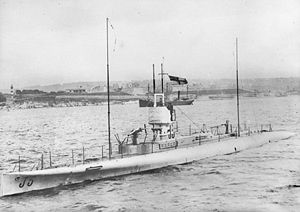British J class submarine

HMAS J5 (ex-HMS J5) in 1919
|
|
| Class overview | |
|---|---|
| Name: | J class submarine |
| Operators: |
|
| In commission: | 1916–1930 |
| Planned: | 8 |
| Completed: | 7 |
| Cancelled: | 1 |
| Lost: | 1 |
| Scrapped: | 6 |
| General characteristics (original design) | |
| Type: | Submarine |
| Displacement: |
|
| Length: | 274 ft (84 m) |
| Beam: | 23 ft 1 in (7.04 m) |
| Draught: | 14 ft (4.3 m) |
| Propulsion: |
|
| Speed: |
|
| Range: | 91 tons Diesel Oil for5,000 nautical miles (9,000 km) at 12.5 knots (23 km/h) |
| Test depth: | 300 feet (91 m) |
| Complement: | 5 officers, 40 seamen |
| Armament: |
|
The J class of submarines was a seven submarine class developed by the Royal Navy prior to the First World War in response to claims that Germany was developing submarines that were fast enough to operate alongside surface fleets. Six were completed during mid-1916, while a seventh entered service at the end of 1917.
Although larger and more powerful than previous British submarines, the J class could not keep up with surface vessels, and operated independently during the war. Between them, the submarines sank a U-boat, and heavily damaged two battleships, with the loss of HMS J6 to friendly shelling.
Following the war, the six surviving submarines were gifted to the Royal Australian Navy (RAN). All six were paid off during the 1920s. Two were scuttled as breakwaters in Port Phillip Bay, and four were scuttled in the ship graveyard off Port Phillip heads.
Shortly before the First World War, incorrect reports reached the British fleet that the Germans were planning a class of fast submarines for operation with the fleet, and British efforts turned toward provision of similar vessels. The driving requirement would be a surface speed that matched the speed of the battlefleet. In order to meet the requirement, the DNC designed a three shaft submarine that was 100-foot (30 m) longer than the E-class, with electric motors confined to the two outer shafts and a hull form based on a light cruiser. This resulted in a diesel-electric design that was unique within the Royal Navy.
The power requirement was 1200 horsepower per diesel engine. In order to meet this power requirement, Vickers, the pre eminent builder of submarine diesels in World War I Britain, elected to produce a 12-cylinder version of their previously successful 100 brake horsepower per cylinder six- and eight- cylinder engines for the D and E classes respectively. They retained the 14.5-by-15-inch (370 by 380 mm) bore and stroke of these previous engines and produced 1200 shaft horsepower at 380 revolutions per minute. These engines eventually went into the J, L-class and M-class submarines.
...
Wikipedia
